2014 May 5
Yoga Pose Brush Strokes
One of the things that I practice apart from yoga is Chinese Calligraphy.
When I'm learning to paint a new character I'll often break it down into brush strokes, practicing small groups of brush strokes at a time so that the character as a whole is easier to learn. This same methodology can be applied to learning yoga poses.
Read more....
2014 Apr 30
Body Awareness Tips: Isolation and Integration
One popular discussion in body awareness fields is about isolation versus integration. There tends to be a pushing away from isolation since that was the focus in the past (i.e. anatomy depicting muscles as isolated entities, reasonably free from connective tissue.) The problem with isolation is that coaches and trainers and physical therapists (and others) tended to focus on muscle isolation exercises to the exclusion of exercises where integration was the goal. An integration exercise is one where the focus is on the whole body working together. It could also involve a switch in mental focus from only a part in isolation to the whole body and even the enviroment.
In this article the author also suggests that muscle isolation exercises are old hat. She suggests instead focusing on feeling the whole body and noticing problem areas that result in non smooth or non-coordinated movement. (And this is a good suggestion).
My own feeling is that muscle isolation still can still have a place in the development of body awareness and responsiveness. Muscle isolation can serve as a teaching and learning tool. why can I activate in one position or movement but I can't activate it in another?
As an example recently I've been practicing activating my tensor fascae latae as part of sequence of muscle activations for the hips. I find that standing on one or body legs it is reasonably easy. But then I was sitting on the edge of a pool with legs straight, and then tried the same activation sequence, I found that I wasn't actually activating my TFL. I could feel with my hand that it was still relaxed.
The difference I realized was that my feet were free, i.e. not on the floor.
Muscle isolation, if used intelligently can be used to deepen body awareness. But why bother?
For myself, one of the reasons that I do muscle isolations is that I'm trying to fix a problem with my hip. It may be the hip, or it may be more to do with the SI joint. In either case being able to isolate muscles, whether to activate or relax or simply to meditate on is one of the main tools that I'm using to explore my problem area. In terms of exploring new movements it's a tool that I use to see if I can find an easier way, a more integrated way of the movement or action or pose.
Now I have been caught in the trap of only practicing isolation, particularly when I teach. But I think it is equally debilitating to focus only on integrated movements. The real benefit can come from being able to effortlessly switch from isolation mode to integration mode and back again.
Better yet is the ability to isolate in different ways.
As an example, in this yoga tree pose article isolated movements (as opposed to isolated muscles) may be used to help bring balance to this asymetrical yoga pose.
A large part of my understanding of isolation vs integration comes learning to fix guns in the army, and later while building a motorcycle from scratch with my dad and uncle. And perhaps the area I've really found it beneficial is in my study of chinese calligraphy and learning to touch type chinese characters. But perhaps one of the best ways to get an understanding of intelligent isolation and how it can lead to improved learning is with the Dance of Shiva.
Body Awareness Tip: What is Yoga?
This was in part inspired by something Ido Portal said but also my own thoughts on what yoga is.
Within a yoga pose, the more we expanding or lengthen, the more we create tension as we stretch the "fabric" of our body.
This is a beginning step towards creating tension. And if we lengthen upwards we work against the "contractive" or "compressive" force of gravity. We also work against the contractive forces within our own body.
From there we can adjust the tension in our body, increasing or decreasing it according to our needs. Two simple needs that we can base the degree of tension on is the need to sense our body and for our body to be responsive. The right amount of tension not only gives us sensory feedback, an ability to "feel" our body, but it also can give it the ability to respond quickly.
Too much tension and we deaden sensitivity as well as responsiveness. Too much slack and we do the same thing.
Using body weight to "work against" we require less tension than the same posture with added external weight (a body weight squat versus a squat with a barbell.)
Going back the ideas of expansion and contraction, with just the right amount of tension we also have just the right amount of space, and that gives the parts of our body room to move with respect to each other. And so two things we can work towards when doing a yoga pose are creating room to move and tuned tension.
And so what about relationships? When we do a balance pose we ideally sense, and maintain, the relationship between ourselves and the earth. An ideal relationship in this case is one where we remain upright while balancing on one foot, or inverted while balancing on the head or hands.
Within ourselves we also have relationships. In each case the ideal relationship is based on the pose that we are doing within the limitations of our body. In the ideal pose, each relationship within our body has room to move or adjust as well as tuned tension.
Body Awareness Tips 6: Become Your Own Mechanic
One reason for improving Body Awareness is so that you can become your own mechanic, at least for the smaller problems.
Read more...
Body Awareness Tip 5: The Muscle Mantra
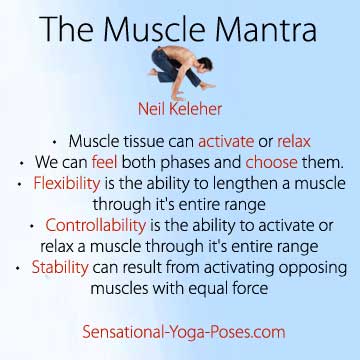
Muscle awareness is the ability to feel our muscles and control them.
As part of developing sensitivity and control I thought it would be helpful to summarize some basic principles for muscle control, both in isolation and in the context of the body as a whole.
Note that the very first point is that muscle tissue can activate and relax. Muscle control is the ability to do both. Just as important is the ability to feel both states so that you can choose from between them and recognize which state (activated, relaxed or somewhere in between) a muscle is in.
I've included what stability is because when it comes to muscle control, both activating and relaxing, it helps to stabilize one end of the muscle that you are controlling.
Also, the more mass a structure has the easier it is to use that structure as a foundation for stability. And so using muscle against muscle we can lock bones and body parts together to create a larger mass for stability.
As an example, using muscular stabilization we can lock the pelvis and lumbar spine together to create a more massive foundation for controlling the hip muscles.
This can be useful whether using the hip muscles for strength or whether we are trying to stretch them.
Body Awareness Tip 4: Feel Your Muscles Activate and Relax
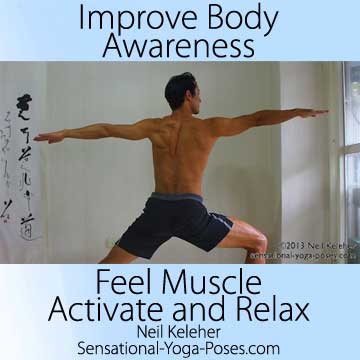
In this photo of warrior 2 I'm deliberately activating the serratus anterior muscle on one side and activating the rhomboid on the other.
I'm using my serratus to move my right shoulder blade away from my spine (protraction) and my rhomboid to move my left shoulder blade towards my spine (retraction.
To learn to feel my shoulder blades and the muscles that act on them I practice moving them. And while I practice moving them I focus on feeling them.
As a result I have learned to differentiate the feelings of protraction and retraction. I can feel which position (if either) my shoulder blades are in.
And as a result, when circumstances permit (they don't always) I can protract or retract my shoulder blades at will.
And so for better body awareness one thing you can do is practice feeling and controlling your muscles.
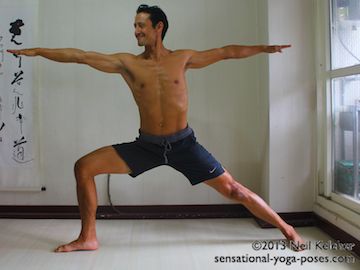
This awareness and control is something that is transferable to any movement situation whether the intent is to move the shoulder blades or stabilize them.
Note that because the serratus anterior is quite thin I'm not actually feeling it activate. Instead I'm feeling the results of it activating.
As for the rhomboids. They are a little easier to feel. I can feel their contraction or "squeezing" when I activate them.
How did I learn to feel the shoulder blades, and how did I develop control? By isolating the shoulder blades and moving them.
See scapular awareness for more on learning to feel and control the shoulder blades. For a taste of how to develop better spinal awareness see multifidus.
And for more about learning to feel and control muscle in general read muscle control.
Body Awareness Tip 3: Notice Your Thoughts
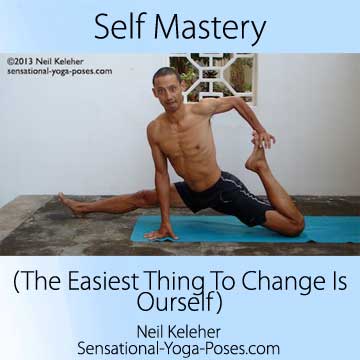
Body awareness isn't just about being aware of the body, it's also about being able to respond, choosing how to act based on what our senses tell us. In turn the awareness that we use to "feel" our body can also extend to noticing the way that we think.
The ability to think (and reason) isn't a bad thing but it can sometimes get in the way of the things that we want to do. And so one way to practice awareness is to notice thoughts. When we notice the thoughts that potentially hinder us, we can then learn to halt those thoughts or change them.
One reason for changing our thoughts (or noticing them in the first place) is that they can affect the way that we perceive our body, and also the world around us. change what we think and the world that we experience may change also.
Read More in Self Mastery (and learn some tips for working towards the splits also.)
Body Awareness Tip 2: Notice Pressure
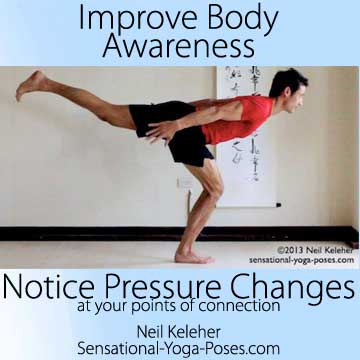
One of the ways to improve body awareness, particularly with respect to balance is to notice the pressure where your body contacts the ground.
Pressure by itself doesn't tell you much. However when you are changing positions or you want to stay still, pressure changes can tell you when you have arrived or when you are moving away from your desired position.
When balancing you can use differences in pressure to feel your center. The point of greatest pressure tells you where your center is.
If you aren't sure where the point of greatest pressure is, try moving, and notice changes in pressure sensation.
If you are on your feet rock back and forwards and notice the way your toes and forefeet press down when your rock forwards. Notice heel pressure increasing as you rock back.
For a more comfortable (and effective experience) rock back and forwards slowly.
And focus on moving smoothly.
Crow Pose
In a pose like crow pose where you are on your hands you can do the same thing. Rock forwards and backwards slowly and notice pressure changes in your fingers as you rock forwards and in the heel of your hand as you rock back. (The movement here is only slight!)
Pressure sensitivity can also be important in the context of binding yoga poses, or any pose where one part of the body presses against another.
Tree Pose
An example of this is tree pose where one foot rests against the inner edge of the other thigh. You could just rest the foot against the inner thigh or actively press it, while noticing the differences in pressure as you do so.
Because you are pressing against your own body, the part being pressed will be affected and the whole nature of the pose will change. Because of this, it can help if you learn how to slowly vary pressure. Slowly increase pressure and slowly decrease it so that it is easier to stay balanced.
Awareness While Walking
If you are walking you can focus on sensing pressure changes by noticing your heels each time they strike the earth. After a few dozen steps shift your focus and notice the way you roll along the outer edge of each foot. Then notice the pressure point where you push off.
By noticing differences between your left and right leg (and the way your feet land) you can look for ways to make corrections. Or you can look for the cause of differences in foot strikes.
Do you swing one leg more than the other? Does your pelvis turn more one way than the other? Is one hip higher than the other? Is one side of the waist shorter?
The reason for feeling pressure isn't just so that you become more aware, it is so that you can respond to what you feel. If you notice that you land differently on one foot than the other you can gradually work towards making both sides feel the same.
Likewise when balancing and using pressure differences to feel your center, if you notice the pressure changing, (telling you that your center is moving) you can take the necessary steps to counteract that movement and position your center where you want it to be.
(For more on learning to feel pressure, particularly with respect to balance, I discuss it extensively in my book "Balance Basics.")
Body Awareness Tip 1: To Feel Your Body Move It (Create Sensation)
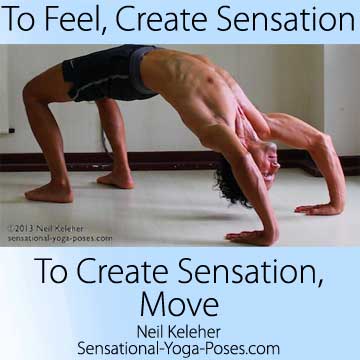
One of the things I work on the most when using my body is focusing on feeling it.
The more I can feel the better I can control it.
How do you learn to feel? By moving.
So that you can calibrate what you feel with what is moving, practice rhythmic movements and practice moving slowly and smoothly.
If you are in a yoga pose and you want to feel a part of your body but are having difficulty, then try moving it (wiggle it) until you find a position that gives you sensation.









